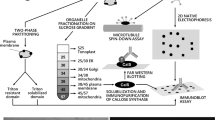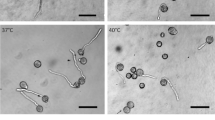Summary
InPicea abies (Norway spruce), microtubules and actin microfllaments both form a dense matrix throughout the tube mainly parallel to the direction of elongation. In these conifer pollen tubes the organization of this matrix is different from that in angiosperms. This study tests our hypothesis that differences in cytoskeletal organization are responsible for differences in tube growth and physiology. Pollen grains were germinated in media containing cytoskeletal disrupters and analyzed for germination, tube length, tube branching, and tip swelling. Disruption of microtubules significantly inhibits tube elongation and induces tube branching and tip swelling. Tip swelling is probably caused by disruption of the microtubules in the tip that are perpendicular to the direction of elongation. Confocal microscopy indicates that colchicine and propyzamide cause fragmentation of microtubules throughout the tube. Oryzalin and amiprophosmethyl cause a complete loss of microtubules from the tip back toward the tube midpoint but leave microtubules intact from the midpoint back to the grain. Disruption of microfilaments by cytochalasins B and D and inhibition of myosin by N-ethylmaleimide or 2,3-butanedione monoxime stops tube growth and inhibits germination. Microfilament disruption induces short branches in tubes, probably originating from defective microfilament organization behind the tip. In addition, confocal microscopy coupled with microinjection of fluorescein-labeled phalloidin into actively growing pollen tubes indicates that microfllament bundles extend into the plastid-free zone at the tip but are specifically excluded from the growing tip. We conclude that microtubules and microfilaments coordinate to drive tip extension in conifer pollen tubes in a model that differs from angiosperms.
Similar content being viewed by others
References
Andersland JM, Fisher DD, Wymer CL, Cyr RJ, Parthasarathy MV (1994) Characterization of a monoclonal antibody prepared against plant actin. Cell Motil Cytoskeleton 29: 339–344
Åström H (1992) Acetylated alpha-tubulin in the pollen tube microtubules. Cell Biol Int Rep 16: 871–881
—, Sorri O, Raudaskoski M (1995) Role of microtubules in the movement of the vegetative nucleus and generative cell in tobacco pollen tubes. Sex Plant Reprod 8: 61–69
Baskin TI, Bivens NJ (1995) Stimulation of radial expression inArabidopsis roots by inhibitors of actomyosin and vesicle secretion but not by various inhibitors of metabolism. Planta 197: 514–521
Cai G, Bartalesi A, Del Casino C, Moscatelli A, Tiezzi A, Cresti M (1993) The kinesin immunoreactive homologue fromNicotiana tabacum pollen tubes: biochemical properties and subcellular localization. Planta 191: 496–506
Collings DA, Wasteneys GO, Williamson RE (1996) Actinmicrotubule interactions in the algaNitella: analysis of the mechanism by which microtubule depolymerization potentiates cytochalasin's effects on streaming. Protoplasma 191: 178–190
Cooper JA (1987) Effects of cytochalasin and phalloidin on actin. J Cell Biol 105: 1473–1478
Cyr RJ (1994) Microtubules in plant morphogenesis: role of the cortical array. Annu Rev Cell Biol 10: 153–180
Dawkins MD, Owens JN (1993) In vitro and in vivo pollen hydration, germination, and pollen tube growth in white spruce,Picea glauca (Moench) Voss. Int J Plant Sci 154: 506–521
Derksen J, Rutten T, Lichtscheidl IK, de Win AHN, Pierson ES, Rongen G (1995a) Quantitative analysis of the distribution of organelles in tobacco pollen tubes: implications for exocytosis and endocytosis. Protoplasma 188: 267–276
Derksen J, Rutten T, van Amstel T, de Win A, Doris F, Steer M (1995b) Regulation of pollen tube growth. Acta Bot Neerl 44: 93–119
de Win AHN, Knuiman B, Pierson ES, Geurts H, Kengen HMP, Derksen J (1996) Development and cellular organizationotPinus sylvestris pollen tubes. Sex Plant Reprod 9: 93–101
Doonan JH, Cove DJ, Lloyd CW (1988) Microtubules and microfilaments in tip growth: evidence that microtubules impose polarity on protonemal growth inPhyscomitrella patens. J Cell Sci 89: 533–540
Fisher DD, Cyr RJ (1998) Extending the microtubule/microfibril paradigm: cellulose synthesis is required for normal cortical microtubule alignment in elongating cells. Plant Physiol 116: 1043–1051
Franke WW, Herth WH, Vanderwoude J, Morré DJ (1972) Tubular and filamentous structures in pollen tubes: possible involvement as guide elements in protoplasmic streaming and vectorial migration of secretory vesicles. Planta 105: 317–341
Frankis RC, Grayson GK (1990) Heat-shock response in germinating pine pollen. Sex Plant Reprod 3: 195–199
Gelfand VI, Bershadsky AD (1991) Microtubule dynamics: mechanism, regulation, and function. Annu Rev Cell Biol 7: 93–116
He Y, Palevitz BA, Wetzstein HY (1996) Pollen germination, tube growth and morphology, and microtubule organization after exposure to benomyl. Physiol Plant 96: 152–157
Heslop-Harrison J, Heslop-Harrison Y (1989) Cytochalasin effects on structure and movement in the pollen tube ofIris. Sex Plant Reprod 2: 27–37
— —, Cresti M, Tiezzi A, Moscatelli A (1988) Cytoskeletal elements, cell shaping and movement in the angiosperm pollen tube. J Cell Sci 91: 49–60
Hoffman JC, Vaughn KC (1994) Mitotic disruptors act by a single mechanism but vary in efficacy. Protoplasma 179: 16–25
— — (1996) Spline and flagellar microtubules are resistant to mitotic disruptor herbicides. Protoplasma 192: 57–69
Hush JM, Wadsworth P, Callaham DA, Hepler PK (1994) Quantification of microtubule dynamics in living plant cells using fluorescence redistribution after photobleaching. J Cell Sci 107: 775–784
Joos U, van Aken J, Kristen U (1994) Microtubules are involved in maintaining the cellular polarity in pollen tubes ofNicotiana sylvestris. Protoplasma 179: 5–15
— —, (1995) The anti-microtubule drug carbetamide stopsNicotiana sylvestris pollen tube growth in the style. Protoplasma 187: 182–191
Kadota A, Wada M (1992) Reorganization of the cortical cytoskeleton in tip growing fern protonemal cells during phytochrome mediated phototropism and blue light induced apical swelling. Protoplasma 166: 35–41
Kohno T, Shimmen T (1988) Accelerated sliding of pollen tube organelles along Characeae actin bundles regulated by calcium. J Cell Biol 106: 1539–1543
Kost B, Spielhofer P, Chua NH (1998) A GFP-mouse talin fusion protein labels plant actin filaments in vivo and visualizes the actin cytoskeleton in growing pollen tubes. Plant J 16: 393–401
Lancelle SA, Hepler PK (1991) Association of actin with cortical microtubules revealed by immunogold localization inNicotiana pollen tubes. Protoplasma 165: 167–172
—, Cresti M, Hepler PK (1987) Ultrastructure of the cytoskeleton in freeze substituted pollen tubes ofNicotiana alata. Protoplasma 140: 141–150
Lazzaro MD (1996) The actin microfilament network within elongating pollen tubes of the gymnospermPicea abies (Norway spruce). Protoplasma 194: 186–194
— (1998) The spermatogenous body cell of the coniferPicea abies (Norway spruce) contains actin microfilaments. Protoplasma 201: 194–201
— (1999) Microtubule organization in germinated pollen of the coniferPicea abies (Norway spruce, Pinaceae). Am J Bot 86: 759–766
Li Y, Moscatelli A, Cai G, Cresti M (1997) Functional interactions among cytoskeleton, membranes, and cell wall in the pollen tube of flowering plants. Int Rev Cytol 176: 133–199
Meske V, Ruppert V, Hartmann E (1996) Structural basis for the red light induced repolarization of tip growth in caulonema cells ofCeratodon purpureus. Protoplasma 192: 189–198
Miller DD, Scordillis SP, Hepler PK (1995) Identification and localization of three classes of myosins in pollen tubes ofLilium longiftorum andNicotiana alata. J Cell Sci 108: 2549–2653
—, Lancelle SA, Hepler PK (1996) Actin microfilaments do not form a dense meshwork inLilium longiflorum pollen tube tips. Protoplasma 195: 123–132
Moore RC, Zhang M, Cassimeris L, Cyr RJ (1997) In vitro assembled plant microtubules exhibit a high state of dynamic instability. Cell Motil Cytoskeleton 38: 278–286
Moscatelli A, Cai G, Ciampolini F, Cresti M (1998) Dynein heavy chain related polypeptides are associated with organelles in pollen tubes ofNicotiana tabacum. Sex Plant Reprod 11: 31–40
Perdue TD, Parthasarathy MV (1985) In situ localization of F-actin in pollen tubes. Eur J Cell Biol 39: 13–20
Pettitt JM (1985) Pollen tube development and characteristics of the protein emission in conifers. Ann Bot 56: 379–397
Pierson ES, Cresti M (1992) Cytoskeleton and cytoplasmic organization of pollen and pollen tubes. Int Rev Cytol 140: 73–125
—, Miller D, Callaham D, Shipley AM, Rivers BA, Cresti M, Hepler PK (1994) Pollen tube growth is coupled to the extracellular calcium ion flux and the intracellular calcium gradient: effect of BAPTA-type buffers and hypertonic media. Plant Cell 6: 1815–1828
Picton JM, Steer MW (1981) Determination of secretory vesicle production rates by dictyosomes in pollen tubes ofTradescantia using cytochalasin D. J Cell Sci 49: 261–272
Raudaskoski M, Åström H, Pertillä K, Virtanen I (1987) Role of the microtubule cytoskeleton in pollen tubes: an immunocytochemical and ultrastructural approach. Biol Cell 61: 177–188
Schwuchow J, Sack FD (1994) Microtubules restrict plastid sedimentation in protonemata of the mossCeratodon. Cell Motil Cytoskeleton 29: 366–374
— —, Hartmann E (1990) Microtubule distribution in gravitropic protonemata of the mossCeratodon. Protoplasma 159: 60–69
Singh H (1978) Embryology of gymnosperms. Gebrüder Borntraeger, Berlin (Handbuch der Pflanzenanatomie, vol 10, 2)
Steer MW, Steer JM (1989) Pollen tube tip growth. New Phytol 111: 323–358
Tang X, Hepler PK, Scordilis SP (1989) Immunochemical and immunocytochemical identification of a myosin heavy chain polypeptide inNicotiana pollen tubes. J Cell Sci 92: 569–574
Taylor LP, Hepler PK (1997) Pollen germination and tube growth. Annu Rev Plant Physiol Plant Mol Biol 48: 461–491
Terasaka O, Niitsu T (1994) Differential roles of microtubule and actin-myosin cytoskeleton in the growth ofPinus pollen tubes. Sex Plant Reprod 7: 264–272
Tiezzi A, Moscatelli A, Cai G, Bartalesi A, Cresti M (1992) An immunoreactive homolog of mammalian kinesin inNicotiana tabacum pollen tubes. Cell Motil Cytoskeleton 21: 132–137
Tiwari SC, Polito V (1988) Organization of the cytoskeleton in pollen tubes ofPyrus communis: a study employing conventional and freeze substitution electron microscopy, immunofluorescence, and rhodamine-phalloidin. Protoplasma 147: 100–112
Tominaga M, Morita K, Sonobe S, Yokota E, Shimmen T (1997) Microtubules regulate the organization of actin filaments at the cortical region in root hair cells ofHydrocharis. Protoplasma 199: 83–92
Yokota E, McDonald AR, Liu B, Shimmen T, Palevitz BA (1995) Localization of a 170 kDa myosin heavy chain in plant cells. Protoplasma 185: 178–187
Zar JH (1984) Biostatistical analysis. Prentice Hall, Englewood Cliffs, NJ
Author information
Authors and Affiliations
Corresponding author
Rights and permissions
About this article
Cite this article
Anderhag, P., Hepler, P.K. & Lazzaro, M.D. Microtubules and microfilaments are both responsible for pollen tube elongation in the coniferPicea abies (Norway spruce). Protoplasma 214, 141–157 (2000). https://doi.org/10.1007/BF01279059
Received:
Accepted:
Issue Date:
DOI: https://doi.org/10.1007/BF01279059




